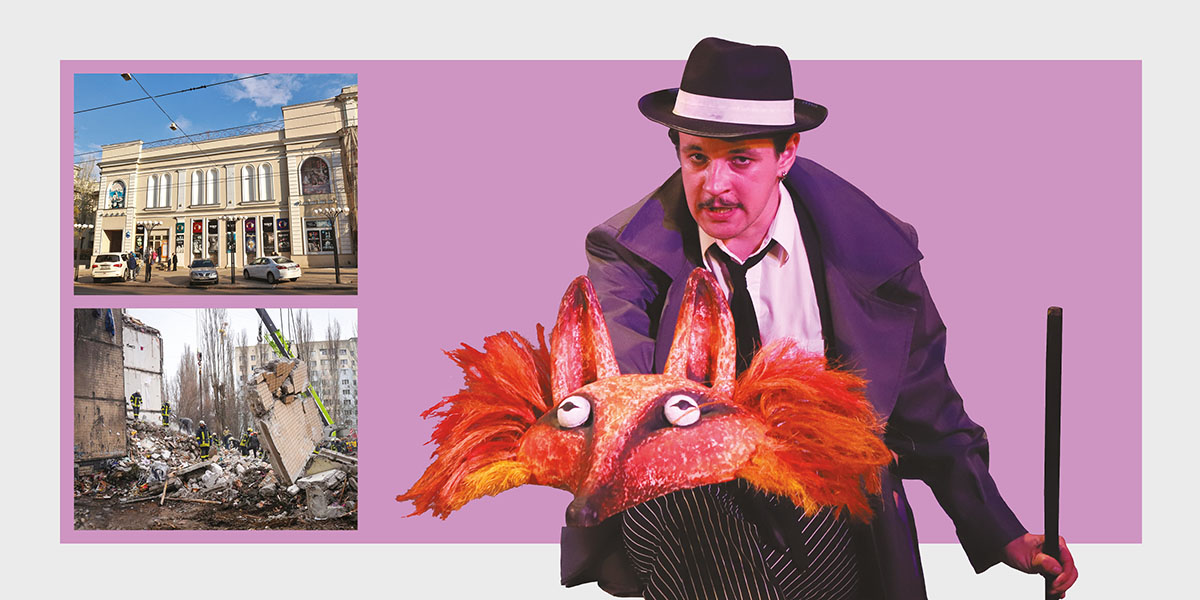Throughout the ongoing conflict in Ukraine, culture and play have developed even in war-torn spaces. During 2023, academics at Odesa Polytechnic (to use the Ukrainian spelling) and Portsmouth University worked collaboratively – remotely and on the ground – to develop, document and analyse how arts such as puppetry have adapted.
We found that puppetry, a well-established artform in Ukraine, has been used as part of the fight against its oppressor, as therapy for traumatised people and as entertainment for positive escapism. In Odesa, puppeteers are still being trained in live animation skills and new performances developed.
These shows are not just for children. Recently, the Odesa Puppet Theatre staged a show for adults, Kaddish, that explores the trauma of the holocaust, providing a way to experience the current trauma of war through a historical view of genocide. It was a very unusual choice to show death and trauma to an audience in the midst of their own violent situation, and Kaddish shows that artists in Ukraine are committed to exploring both the joy and power of puppetry in sensitive, difficult narratives.
Histories of survival
The Odesa Puppet Theatre, formed in 1932, has a history of survival. It continued through both the 1930s famine and the second world war. It is going strong during the current war, partly because its workers see their activities as serving the nation’s fight against an invading army and take huge pride in their work. Two theatre workers painted a vivid picture of the theatre now: ‘It became more difficult to work. Very often rehearsals and performances are interrupted by air-raid alarms. Many personnel left Odesa, some are serving in the armed forces, many are engaged in volunteer activities.
‘Our audience is children from the age of three. Some do not yet understand what war is, but they feel anxious because they cannot live as they did before. Many sought solace from anxiety in computers and video games, so we had a lot of appreciation from parents when we got the plays back up and running. It’s an important opportunity for people to go to the theatre, to see a play, to see the victory of good over evil. This victory is vividly shown in most of our performances. But we do not have evil as ruthless and cruel. Our evil is funny. It is ridiculed. In many cases, this gives hope that something will change for the better.
‘If there is an alarm, we go to the shelter and continue the performance. A puppeteer descends with the children. We also conduct interactive guided tours with workshop elements. Schoolchildren come to these events and explore the intricacies of puppetry and try working with puppets.’
The staff are committed to carrying on. Only on days of mourning are shows cancelled. As the war continues, the theatre remains a vital place of solace.
Effective objects
Hopeful activities are largely possible because of the puppetry infrastructure that developed in 20th-century Ukraine. Across eastern Europe, puppetry first flourished as a form of folk art, then through the period of Soviet influence. Stalin was a fan of puppetry, in particular the great artist Sergey Obraztsov, who popularised the form post-war. In this period, puppetry reflected prevalent ideologies in some contexts but in others practitioners used it to resist oppression – as documented by puppet historian Henryk Jurkowski. Famous puppeteers included symbolic messages in their shows that were critical of the Soviet regime, as in Poland. Puppets can get away with ‘saying’ risky things.
The long heritage of Ukrainian puppetry includes a nativity-style performance called Vertep, which was recently employed in a satirical form presenting Vladimir Putin as Herod. Other storytelling innovations include using animals to represent the current situation, as in Rivne Puppet Theatre’s 2022 show Refugee Cats, informed by the personal experiences of its authors Liudmyla Tymoshenko and Maryna Smilianets in Kyiv. The production uses Aesopian language and characters such as ‘the volunteer cat’ and ‘the disabled cat’, with events seen through the eyes of its main character, a kitten puzzled by the war. The company has toured the play all around the Rivne region and for local displaced communities.
‘If there is an air-raid alarm, we go to the shelter and continue the performance. A puppeteer descends with the children’
These events follow a varied, long-documented history of puppetry at play during wartime. It has often been deployed in campaigns, as visually and textually documented by Eileen Blumenthal in her 2005 book Puppetry and Puppets: An Illustrated World Survey. In his 1998 study of Spanish civil war puppetry in Theatre Research International, James McCarthy describes puppetry as ‘one of the most ancient theatrical forms’, noting that it ‘became for republicans an element of contemporary struggle, adopting a role in anti-fascist propaganda’. McCarthy found a review of a contemporary Spanish play that named ‘the puppet as no less useful than the rifle in the successful prosecution of the war’.
Some similar ‘war puppets’ are now in museums such as the Berlin Puppet Museum and closer to home in Portsmouth’s D-Day Museum, which features a ventriloquist puppet named Bertie, which accompanied British soldier Captain North across the beaches of Normandy.
Puppets are complex objects. They may be used as weapons, to displace difficult dialogues, to offer solace to audiences. As researchers, we are translating accounts and scholarly discussion of puppetry, much of which has already been published in Ukrainian. Our hope is to continue documenting and celebrating Ukrainian puppetry – a vital cultural art form that needs protecting during volatile times of global conflict.
Research for the project detailed in this article was funded by UK Research and Innovation, with more findings forthcoming in Puppetry International Research











